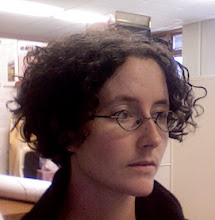Today was our biggest traveling day yet. Woke up at 5:15, took bags out to the front porch, packed a lunch, ate breakfast, on the trail by 6 am. Our departure time was dicatated by the tide -- we had to cross the Rio Claro on a low tide, to keep the crocs, sharks, and dangerous flow at bay. The hike out was 20 km, just like the hike in, but on very different terrain, and on a schedule. Trucks were waiting to pick us up at the end at noon. Maybe a third of the hike was on sandy beach, which is like hiking through molasses. No fun when you're in a hurry. I had to pack up my binoculars and push myself to move fast the whole morning. I notice how short my legs are hiking in sand, too. Plod, plod. But it was spectacular -- miles and miles of undeveloped sandy beach, beautiful surf, groves of palms. Lots of coconuts germinating, really impressive. The palms pop out of the nut as enormous seedlings.
Luckily it was relatively cool and misty, so we didn't get the full fury of the sun. I got a bit red, but not really burned. We even got a tiny sprinkle of rain on the last stretch of beach. And even though I was sad not to stop and look at everything closely, hiking hard felt good. Gwen walked the last bit of beach with me -- our legs and temperaments match. I was so happy when we finally stumbled in to the little shop where everyone was waiting in the shade to get on the trucks. I bought an ice cold orange fanta and took my boots and socks off. It was blissful.
After a 30 minute break, we piled into 4 trucks. I was a bit worried about them, thinking I might get motion sick or be too tired, but it turns out that riding in the back of those open trucks cures all my ills. I love it! We had a tarp over the top for shade, but the front and back were open. Lots of fresh air. Joe, Elena, Aaron, Sara, Jess, Bill and I shared a truck. We sang and laughed for the whole 2-hour trip to Puerto Jimenez. We even got to see a tayra (huge black weasel) crossing the road in front of us. When it started to rain, the driver got out and pulled down the front of the tarp to keep us dry. Other OTSers weren't as lucky, their trucks' tarps didn't even go all the way down the side. We laughed at them as we sped by. :)
We had 20 minutes to walk around Puerto Jimenez, a charming little coastal town. I got a cheese empanada and a phone card. From there it was just a short drive to the dock, where we piled out and waited for another 30 minutes or so until our boat showed up. There were just enough seats for all of us. It only took 45 minutes to get across the gulf, and then we sat for another half hour on another dock until our bus showed up. I had time to use the bathroom in the supermarket nearby. I marveled at the mirror, electric light, and bar of soap. It didn't even smell like urine in there. It was awesome. Everybody stocked up on beer and cookies, and then it was 2 more hours on the big bus to Las Cruces.
Las Cruces is the third OTS field station, and the last stop for our course (we'll spend one day in the middle at Las Alturas). After Corcovado, this feels like a resort. There is electricity all the time. We don't have to go outside to the bathroom. There are hot showers. We get to serve ourselves food (the last 3 sites plated up food for us -- which meant I ALWAYS ate more than I wanted to. You don't want to make the cooks mad.) There are pillows. And I haven't seen a single biting arthropod. The only danger here is snakes. It's also a botanical garden, a great opportunity for me to solidify some of the tropical groups i've been learning. And half of Costa Rica's birds can be found here. I'm in heaven!
Oh, so I forgot about bird lists! Here are the new birds I picked up at Corcovado: great tinamou, mangrove black-hawk, semipalmated plover, whimbrel, ruddy turnstone, least sandpiper, ruddy ground-dove, black-hooded antshrike, riverside wren, crested guan, scarlet macaw, fiery-billed aracari, golden-naped woodpecker, chestnut-backed antbird, golden-crowned spadebill, sulfur-rumped flycatcher, eye-ringed flatbill, house wren, white-shouldered tanager, white-throated shrike-tanager, cherrie's tanager, green honeycreeper, dusky-capped flycatche, ruby-throated hummingbird.





















